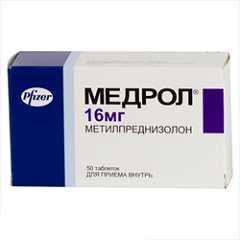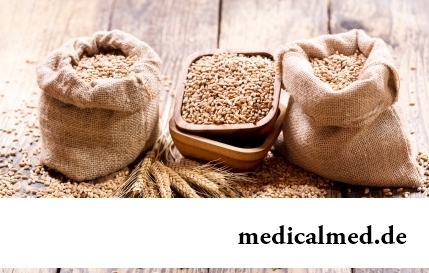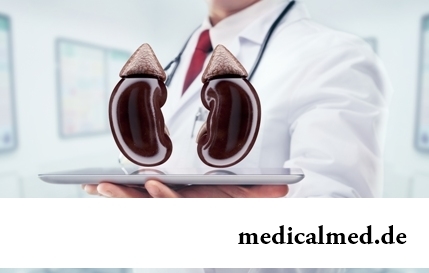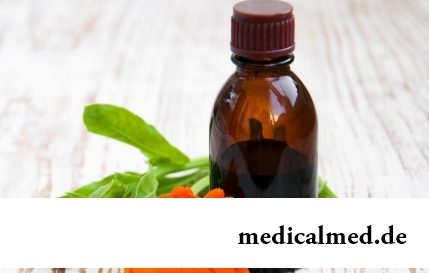





Medrolum
Application instruction:
 Medrolum – a glucocorticosteroid (GKS) for intake.
Medrolum – a glucocorticosteroid (GKS) for intake.
Form of release and structure
Dosage form – tablets: an elliptic form, white color, on one party two notches (cross-wise), are applied on another – a logo engraving, on 4 mg (on 10 pieces in blisters, in a cardboard pack of 1, 3 or 10 blisters; on 30 pieces in glass bottles of dark color, in a cardboard pack 1 bottle); on 16 mg (in a blister strip packaging on 10 pieces, in a cardboard pack of 5 packagings, or on 14 pieces, in a cardboard pack 1 packaging; on 50 pieces in glass bottles of dark color, in a cardboard pack 1 bottle); on 32 mg (on 20 or 50 pieces in glass bottles of dark color, in a cardboard pack 1 bottle).
Active agent of Medrolum – Methylprednisolonum, in 1 tablet with an engraving:
- UPJOHN – 4 mg;
- UPJOHN of 73 - 16 mg;
- UPJOHN of 176 - 32 mg.
Auxiliary components of tablets with a text:
- UPJOHN: lactose, starch corn, the starch which corn is dried up, sucrose, calcium stearate;
- UPJOHN 73 and UPJOHN 176: liquid paraffin, calcium stearate, lactose, starch corn, sucrose.
Indications to use
- Aspiration pneumonitis, the symptomatic sarcoidosis disseminated or fulminant pulmonary tuberculosis (as a part of the corresponding antitubercular chemotherapy), Leffler's syndrome (in the absence of effect of therapy by other drugs), a berylliosis;
- Combination therapy of tubercular meningitis with the subarachnoidal block or at threat of the block;
- Endocrine pathologies: an inborn adrenal struma, primary and secondary adrenal insufficiency, a subacute and chronic thyroiditis, a hypercalcemia against the background of malignant new growths;
- Idiopathic Werlhof's disease and secondary thrombocytopenia (at adult patients), autoimmune hemolitic anemia, inborn hypoplastic anemia, erythrocyte anemia;
- Treatment of acute forms of general diseases of connecting fabric at a rheumatic carditis, a system dermatomyositis (polymiositis), a system lupus erythematosus, a rheumatic polimialgiya, giant-cell arteritis (it is in some cases shown as a maintenance therapy);
- Skin pathologies: pemphigus, heavy multiformny erythema (Stephens-Johnson's syndrome), herpetiform violent dermatitis, fungoid mycosis, exfoliative dermatitis, heavy seborrheal dermatitis, heavy psoriasis;
- Additional (short-term) therapy of diseases of a musculoskeletal system, including rheumatic pathologies: at an aggravation or acute forms of psoriasis arthritis, a pseudorheumatism (including a juvenile pseudorheumatism), an ankylosing spondylitis, a bursitis, a nonspecific tendosinovit, gouty arthritis, a posttraumatic osteoarthritis, an epicondylitis, a synovitis at an osteoarthritis;
- Treatment of serious (disabling) conditions (in case of inefficiency of usual therapy) at seasonal or year-round allergic rhinitis, reactions of hypersensitivity to medicines, a serum disease, contact dermatitis, atopic dermatitis, bronchial asthma;
- The chronic and heavy acute inflammatory and allergic processes connected with diseases of eyes: keratitis, optic neuritis, chorioretinitis, iritis and iridocyclitis, allergic regional helcomas, inflammation of a front segment of an eye, allergic conjunctivitis, sympathetic ophthalmia, diffusion back uveitis and choroiditis;
- Palliative therapy at oncological diseases: adults have leukoses and lymphoma, children have acute leukoses;
- Stimulation of a diuresis and achievement of remission of a proteinuria at patients with nephrotic a syndrome without uraemia, against the background of a system lupus erythematosus or idiopathic type;
- Acute forms of ulcer colitis and regional enteritis (for removal of the patient from a critical state);
- Trichinosis with defeat of a nervous system or a myocardium;
- Brain hypostasis against the background of a brain tumor, an exacerbation of multiple sclerosis;
- As a part of complex therapy at organ transplantation.
Contraindications
- Breastfeeding period;
- Hypersensitivity to drug components.
With care it is necessary to appoint drug sick with an esophagitis, a peptic ulcer of a stomach and duodenum, gastritis, an intestinal anastomosis (in the next anamnesis), a latent or acute round ulcer, a diverticulitis, nonspecific ulcer colitis (at threat of perforation or abscess), a lipidemia, a diabetes mellitus and predisposition to it, osteoporosis, a myasthenia, a hypothyroidism, acute psychosis, a hyperthyroidism, a subacute and acute myocardial infarction, arterial hypertension, the congestive heart failure expressed by a renal failure or a liver (especially against the background of the accompanying hypoalbuminemia), an open angle glaucoma; at a herpes simplex (an eye form), HIV infection (AIDS), measles, chicken pox, a strongyloidosis.
At latent and active tuberculosis, severe forms of viral or bacterial infections use of Medrolum is possible only as a part of specific therapy (masks symptoms of a disease and increases risk of development of superinfection).
Appointment at system fungal infections is not recommended.
During pregnancy use of drug is admissible only according to absolute indications.
Route of administration and dosage
Pill is taken inside.
The mode of dosing is appointed by the doctor on the basis of clinical indications.
Selection of a dose needs to be made individually, considering reaction of the patient to therapy.
The recommended daily dosing:
- Adults: an initial dose – 4-48 mg, make further correction depending on the nature of a disease and a condition of the patient. So at multiple sclerosis the dose can make 200 mg, wet brain – 200-1000 mg, organs transplantation – of calculation to 7 mg on 1 kg of body weight a day. In the absence of therapeutic effect as a result of the sufficient period of reception of Medrolum drug should be replaced with other means;
- Children: the dose is defined with the surface area of a body or the child's weight, so for treatment of insufficiency of adrenal glands the dose can make 3,33 mg on 1 sq.m or 0,18 mg on 1 kg a day, for other indications – 12,5-50 mg on 1 sq.m or on 0,42-1,67 mg on 1 kg a day. The daily dose is evenly distributed on 3 receptions.
Drug withdrawal after prolonged use should be carried out gradually.
At positive dynamics of treatment, gradually reducing an initial dose, the patient should pick up the lowest maintenance dose which will allow to keep the reached clinical effect.
Use of drug needs to be accompanied with constant control of the mode of dosing. Dose adjustment can be required at change of a clinical state in case of an exacerbation of a disease, approach of remission, individual reaction of the patient to drug or against the background of the stressful situations which are directly not connected with a disease.
Use of Medrolum is shown with use of a method of alternating therapy at which the doubled daily dose is accepted 1 time in the morning every other day. This method of treatment allows to reach the maximum clinical effect at long reception and it is essential to reduce the side effects of drug connected with delay of growth at children, suppression of pituitary and adrenal system, GKS withdrawal.
Side effects
- Alimentary system: gastric bleeding, a round ulcer (with risk of a perforation and bleeding), pancreatitis, perforation of a gut, an esophagitis, increase in activity of alaninaminotranspherase, aspartate aminotransferase and an alkaline phosphatase in blood serum (usually changes have passing and insignificant character);
- Metabolism: chronic heart failure at predisposed patients, a sodium delay, increase in arterial pressure, potassium loss, a gipokaliyemichesky alkalosis, a liquid delay in an organism, negative nitrogenous balance against the background of a catabolism of proteins;
- Endocrine system: development of a syndrome of Cushing, a hirsutism, suppression of pituitary and adrenal system, decrease in tolerance to carbohydrates, emergence of a latent diabetes mellitus, at patients with a diabetes mellitus increase in need for peroral hypoglycemic means or insulin, disturbances of a menstrual cycle; children have growth delay;
- Musculoskeletal system: muscular weakness, a steroid myopathy, osteoporosis, ruptures of sinews (is more often than an Achilles tendon), compression fractures of vertebras, pathological changes, an aseptic necrosis of an epiphysis of tubular bones;
- Nervous system: increase in intracranial pressure, mental disorders, pseudoneoplasm of a brain, spasm;
- Organ of sight: increase in intraocular pressure with risk of injury of an optic nerve, a back subkapsulyarny cataract, an exophthalmos;
- Allergic reactions: hypersensitivity reactions, including allergic system reactions, perhaps, suppression of reactions at skin tests;
- Dermatological reactions: petechias and ecchymomas, delay of processes of healing of wounds, decrease in durability and thinning of skin;
- Others: activation of latent infections, distortion of a clinical picture at infectious pathologies, developing of opportunistic infections, GKS withdrawal.
Special instructions
Considering a high risk of development of complications at glucocorticoid therapy, it is necessary to appoint Medrolum in the lowest doses providing clinical effect. In case of correction of the mode of therapy the dose of drug is reduced gradually.
Use of drug can exponentiate development of mental disorders, including sleeplessness, euphoria, a depression, acute psychotic manifestations, or to increase the available emotional instability of the patient. Or after it increase in a dose of drug is shown to patients, inclined to psychotic reactions, in the period of a stress.
During administration of drug in the dose having immunodepressive effect, the patient cannot enter live or live attenuated vaccines, introduction of the killed or the inactivated vaccines is shown, at the same time reaction to their introduction can be reduced. If the dose does not possess an immunodepressive effect, immunization can be carried out according to the corresponding indications.
Action of Medrolum can erase a clinical picture of some infections or cause development of new. During administration of drug the organism can lose resistance to infections or ability to localization of infectious process.
The risk of development of infectious complications increases in proportion to increase in the accepted dose of drug both at monotherapy, and at a combination with other immunodepressants. The infections caused by pathogenic microorganisms (viruses, mushrooms, bacteria, helminths or protozoa), can proceed in an easy and severe form, up to a lethal outcome.
At active tuberculosis use is shown at treatment of the disseminated and fulminant tuberculosis, in a combination with the corresponding antitubercular chemotherapy. At appointment to patients to positive tuberkulinovy tests or latent tuberculosis there can be a process reactivation therefore treatment should be accompanied with strict medical control. Long reception of Methylprednisolonum at such patients should be carried out with co-administration of the corresponding preventive treatment.
With care it is necessary to apply at treatment of a herpes simplex of eyes because of risk of perforation of a cornea.
Long therapy by drug can promote accession of a consecutive eye viral or fungal infection, cause development of allergic reactions, developing of a back subkapsulyarny cataract, glaucoma with possible damage of an optic nerve.
High doses of Methylprednisolonum can become the reason of increase in arterial pressure, excretion of potassium, a delay of ions of sodium and water. During treatment the patient should limit consumption of table salt and to appoint potassium administration of drugs.
Medrolum increases calcium removal.
Frequent side effect of long use of high doses of drug is osteoporosis.
The long daily mode of dosing with administration of drug several times in days at treatment of children has to be applied only according to absolute indications as can cause a growth inhibition of the child. Alternating therapy allows to minimize or avoid this undesirable effect.
The gradual dose decline of drug allows to minimize manifestations of secondary insufficiency of bark of adrenal glands. This type of pathology can be observed after the end of treatment within several months therefore at emergence of any stressful situations during the specified period repeated purpose of Medrolum is necessary. Due to the possible disturbance of secretion of mineralokortikoid the accompanying purpose of mineralokortikoid and/or electrolytes is shown.
More expressed action of glucocorticosteroids is noted at patients with cirrhosis and a hypothyroidism.
Therapy can mask signs of a round ulcer therefore without the expressed pains the patient can have a bleeding or perforation.
Against the background of therapy cases of development in patients of sarcoma of Kaposha are noted, at drug withdrawal approach of clinical remission is possible.
The negative impact on reproductive function, mutagen and cancerogenic effect of drug is not established.
Medicinal interaction
Use of Medrolum in a combination with other medicines is possible only on doctor's orders.
Terms and storage conditions
To store at a temperature of 20-25 °C. To protect from children.
Period of validity – 5 years.
Name of drug
Price
Drugstore
Medrolum тбл 4 mg No. 30, Pharmacia Italia/Pfizer
173 rub.
 Network of the Moscow drugstores of IFC
Network of the Moscow drugstores of IFCMedrolum тбл 16 mg No. 50, Pharmacia Italia/Pfizer
646 rub.
 Network of the Moscow drugstores of IFC
Network of the Moscow drugstores of IFCMedrolum тбл 32 mg No. 20, Pharmacia Italia/Pfizer
698 rub.
 Network of the Moscow drugstores of IFC
Network of the Moscow drugstores of IFCThe person accepting antidepressants in most cases will have a depression again. If the person coped with depression by own efforts, he has every chance forever to forget about this state.

Each of us repeatedly noticed that the people having the same passport age are sometimes not similar on one-years at all. One...
Section: Articles about health
Work of a brain is extremely complex and in many respects is not studied yet. It is confirmed also by the features of thought processes which are shown when the person sleeps. Let's tell about some of them....
Section: Articles about health
Each person supports all life a SARS about 200 times. The peak of incidence falls on cold season, but it is possible to get sick with a temperature and a pharyngalgia, and sometimes and very possibly, even during a heat. The reasons for development of catarrhal diseases there is a set: from the weakened immunity till an excess portion of ice cream....
Section: Articles about health
Small appetite at the child – the complaint which pediatricians should hear practically from each mother. Most often it is carried to разр...
Section: Articles about health
Neurosis is called pathology of a nervous system at which deviations in functioning of the highest nervous processes are observed. Most often - owing to yet not strengthened mentality - children are subject to neurosises. Premises to emergence of such disturbances can become нез...
Section: Articles about health
The fatigue, sleep debt, disturbances of food, bad mood, vagaries of the weather – all these circumstances badly affect our appearance. Especially the person suffers: skin becomes flabby, loses healthy color, becomes covered by wrinkles, zones of hypostases and dark circles under eyes appear. It is not always possible to be saved from influence of aggressive factors, but we are quite able to minimize its effects. For this purpose usually apply the cosmetics and procedures helping увлаж...
Section: Articles about health
Within several decades of our compatriots convinced that the use of butter nasty affects on...
Section: Articles about health
The concept "gluten" (differently, a gluten) combines group of the proteins which are a part of rye, barley and wheat. For most of people the use of the food stuffs containing a gluten not only is safe, but also it is very useful. Nevertheless, there is a number the myth...
Section: Articles about health
New year, wedding, birthday, office party – an occasion to drink at the Russian person will always be. How to reduce a negative impact of alcohol by an organism and to avoid a condition of strong intoxication? The most correct council – to refuse the use of alcoholic drinks. Council is true, but not always feasible. We offer several advice which will help you in cases when it is impossible to avoid alcohol intake....
Section: Articles about health
For many women the word "fat" sounds as a sentence. In aspiration to an ideal figure they try to exclude, first of all, from with...
Section: Articles about health
Life activity of one-celled fungi of the sort Candida, related to yeast is a proximate cause of development of candidiasis (milkwoman). Normal these microorganisms are a part of the microflora living in an oral cavity and intestines of most of people, and that...
Section: Articles about health
Kidneys perform the most important function of clarification of blood from those products of metabolic processes which cannot be used by an organism for obtaining energy and construction of new cells. With the urine produced by kidneys from a body of the person the bulk of the toxins getting to it with food and water is removed. Normal functioning of kidneys provides removal from an organism of excess liquid and maintenance of optimum ionic balance. At emergence of failures in work of secretory system...
Section: Articles about health
The nature does not stand stagnation and monotony. It is known that tissues of a human body atrophy if do not receive necessary loadings...
Section: Articles about health
EKO, or extracorporal fertilization - a method of treatment of infertility which became the reason of a set of broken-down copies in due time accused the people working on its creation neither more nor less of rivalry good luck. Already very few people deny the rights...
Section: Articles about health
It would seem, about it there can be no disagreements: water is necessary for a human body for normal life activity, and about how and when it should be drunk, all know. It turned out that the situation is not absolutely so: for many years there are very persistent delusions connected with this question. Let's consider the most widespread of them....
Section: Articles about health
Residents of big cities quite often have a disease which is known as the syndrome of chronic fatigue (SCF) today. This illness...
Section: Articles about health
Radiological methods of a research are applied in medicine more than hundred years, and thanks to them millions of lives were saved. In many cases without X-ray it is impossible to make exact idea of a condition of bodies and fabrics, it is correct to make the diagnosis. Those...
Section: Articles about health
Traveling all over the world, many try to try the most exotic dishes of national cuisines. There is even a so-called gastronomic tourism which, according to gourmets, not only allows to receive new feelings, but also is capable to show life of other people from absolutely unexpected side....
Section: Articles about health
Osteoporosis this general disease which main sign is decrease in density of a bone tissue. On width распростран...
Section: Articles about health
Quite large number of people adheres to the principles of vegetarian food. But how to be if in a family of vegetarians there are children? Whether it is possible to eat also it the same as to parents, or after all the children's organism is not adapted for the use only раст...
Section: Articles about health
For anybody not a secret that the modern person eats not as his ancestors. For the last 100 years in broad access there were absolutely new products which are result of use of the latest technologies in food production. Significantly ways of storage and transportation of food ingredients changed, and people of the whole world had an opportunity to regularly use those products about which their grandfathers and grandmothers did not even know....
Section: Articles about health
A lot of things depend on a condition of a backbone in a human body, a backbone - not only a support for a body, it also contain...
Section: Articles about health
It is known that the person for 80% consists of water which participates in all processes of an organism. The person loses liquid daily – as a result of sweating, breath, an urination, and its insufficient completion due to various reasons can bring to обезвожив...
Section: Articles about health
Each person knows that fervescence is an illness sign. However too low temperature (hypothermia), especially also can demonstrate existence of diseases when it is observed long enough. Such state is dangerous that it, unlike fever, does not give a serious inconvenience: patients usually complain only of weakness, drowsiness, apathy. Sometimes the fever and a cryesthesia in extremities joins. Many people at similar symptoms...
Section: Articles about health
The cosmetics intended for improvement of a condition of skin, nails and hair are used by each woman. Expenses on регуля...
Section: Articles about health
The person, as well as all other beings living on our planet feels weather changing. It is the normal meteosensitivity which is not causing to healthy people of special troubles. Meteodependence, on the contrary, is morbid condition, характеризующимс...
Section: Articles about health
Transfusion of donor blood has almost century history. In spite of the fact that this procedure is quite usual for many people, process of blood donation is still surrounded with numerous myths. Today we aimed to discredit the most widespread of them....
Section: Articles about health

